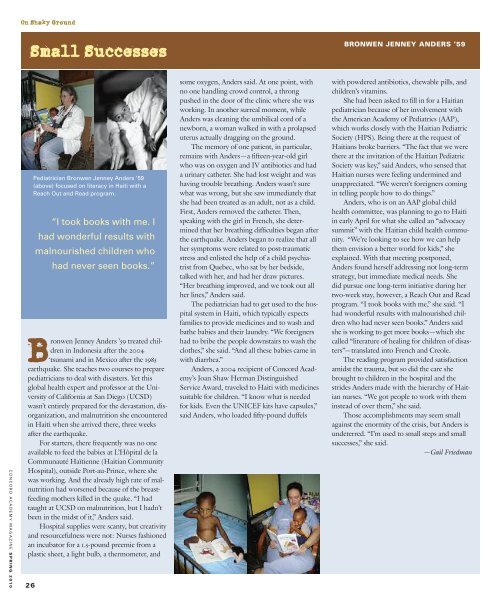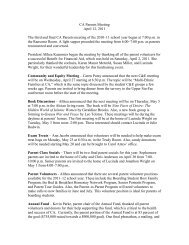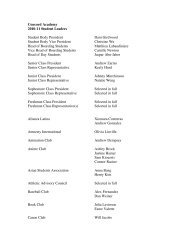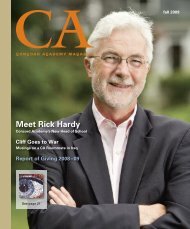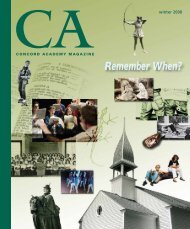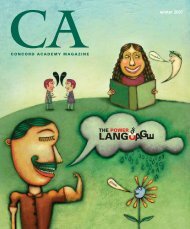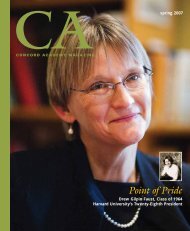Class Notes
S - Concord Academy
S - Concord Academy
- No tags were found...
You also want an ePaper? Increase the reach of your titles
YUMPU automatically turns print PDFs into web optimized ePapers that Google loves.
On Shaky GroundSmall SuccessesBRONWEN JENNEY ANDERS ’59C O N C O R D A C A D E M Y M A G A Z I N E S P R I N G 2 0 1 0Bronwen Jenney Anders ’59 treated childrenin Indonesia after the 2004tsunami and in Mexico after the 1985earthquake. She teaches two courses to preparepediatricians to deal with disasters. Yet thisglobal health expert and professor at the Universityof California at San Diego (UCSD)wasn’t entirely prepared for the devastation, disorganization,and malnutrition she encounteredin Haiti when she arrived there, three weeksafter the earthquake.For starters, there frequently was no oneavailable to feed the babies at L’Hôpital de laCommunauté Haïtienne (Haitian CommunityHospital), outside Port-au-Prince, where shewas working. And the already high rate of malnutritionhad worsened because of the breastfeedingmothers killed in the quake. “I hadtaught at UCSD on malnutrition, but I hadn’tbeen in the midst of it,” Anders said.Hospital supplies were scanty, but creativityand resourcefulness were not: Nurses fashionedan incubator for a 1.5-pound preemie from aplastic sheet, a light bulb, a thermometer, and26Pediatrician Bronwen Jenney Anders ’59(above) focused on literacy in Haiti with aReach Out and Read program.“I took books with me. Ihad wonderful results withmalnourished children whohad never seen books.”some oxygen, Anders said. At one point, withno one handling crowd control, a throngpushed in the door of the clinic where she wasworking. In another surreal moment, whileAnders was cleaning the umbilical cord of anewborn, a woman walked in with a prolapseduterus actually dragging on the ground.The memory of one patient, in particular,remains with Anders—a fifteen-year-old girlwho was on oxygen and IV antibiotics and hada urinary catheter. She had lost weight and washaving trouble breathing. Anders wasn’t surewhat was wrong, but she saw immediately thatshe had been treated as an adult, not as a child.First, Anders removed the catheter. Then,speaking with the girl in French, she determinedthat her breathing difficulties began afterthe earthquake. Anders began to realize that allher symptoms were related to post-traumaticstress and enlisted the help of a child psychiatristfrom Quebec, who sat by her bedside,talked with her, and had her draw pictures.“Her breathing improved, and we took out allher lines,” Anders said.The pediatrician had to get used to the hospitalsystem in Haiti, which typically expectsfamilies to provide medicines and to wash andbathe babies and their laundry. “We foreignershad to bribe the people downstairs to wash theclothes,” she said. “And all these babies came inwith diarrhea.”Anders, a 2004 recipient of Concord Academy’sJoan Shaw Herman DistinguishedService Award, traveled to Haiti with medicinessuitable for children. “I know what is neededfor kids. Even the UNICEF kits have capsules,”said Anders, who loaded fifty-pound duffelswith powdered antibiotics, chewable pills, andchildren’s vitamins.She had been asked to fill in for a Haitianpediatrician because of her involvement withthe American Academy of Pediatrics (AAP),which works closely with the Haitian PediatricSociety (HPS). Being there at the request ofHaitians broke barriers. “The fact that we werethere at the invitation of the Haitian PediatricSociety was key,” said Anders, who sensed thatHaitian nurses were feeling undermined andunappreciated. “We weren’t foreigners comingin telling people how to do things.”Anders, who is on an AAP global childhealth committee, was planning to go to Haitiin early April for what she called an “advocacysummit” with the Haitian child health community.“We’re looking to see how we can helpthem envision a better world for kids,” sheexplained. With that meeting postponed,Anders found herself addressing not long-termstrategy, but immediate medical needs. Shedid pursue one long-term initiative during hertwo-week stay, however, a Reach Out and Readprogram. “I took books with me,” she said. “Ihad wonderful results with malnourished childrenwho had never seen books.” Anders saidshe is working to get more books—which shecalled “literature of healing for children of disasters”—translatedinto French and Creole.The reading program provided satisfactionamidst the trauma, but so did the care shebrought to children in the hospital and thestrides Anders made with the hierarchy of Haitiannurses. “We got people to work with theminstead of over them,” she said.Those accomplishments may seem smallagainst the enormity of the crisis, but Anders isundeterred. “I’m used to small steps and smallsuccesses,” she said.—Gail Friedman


